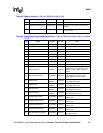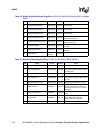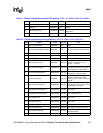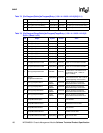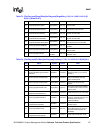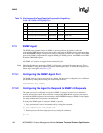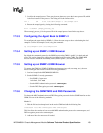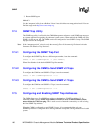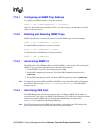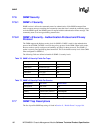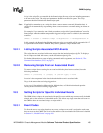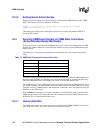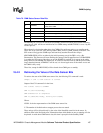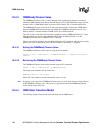
MPCMM0001 Chassis Management Module Software Technical Product Specification 161
SNMP
17.5.1 Configuring an SNMP Trap Address
To configure an SNMP trap address, issue the command:
cmmset -l cmm -d SNMPTrapAddressN -v [IP address]
where N is the number of the trap address from 1 to 5 that is being set, and IP address is the IP
address of the trap receiver.
17.5.2 Enabling and Disabling SNMP Traps
SNMP Trap addresses are enabled by default. To disable SNMP traps, issue the command:
cmmset -l cmm -d SNMPenable -v disable
To enable SNMP trap addresses, issue the command:
cmmset -l cmm -d SNMPenable -v enable
To check the status of SNMP traps, issue the command:
cmmget -l cmm -d SNMPenable
17.5.3 Alerts Using SNMP v3
The CMM utilizes the SNMPtrap utility to send the SNMP v3 ‘trap’ message. For receiving the
SNMP v3 Trap, the remote application such as the trap listener needs to:
1. Set the SNMP v3 Trap User. The default trap user is root.
2. Set the MD5 Authentication password. The default MD5 Authentication password: is
publiccmm.
3. Set the DES Encryption password. The default DES Encryption password is publiccmm.
Note: To change the passwords (MD5 and DES) for SNMP v3 trap, change the snmpTrapCommunity
from the CLI interface using “cmmset -d snmpTrapCommunity” or from the SNMP
manager console.
17.5.4 Alert Using UDP Alert
The CMM Management software also sends the alert via UDP port 10000. The IP address to
receive this alert is the same as the SNMP Trap IP addresses. The UDP alert is enabled by default
when the user enables SNMP traps and disabled when SNMP Traps are disabled. See
Section 17.5.2 for enabling and disabling SNMP Traps.
Note: The UDP Alert portion of the SNMP trap functionality is being deprecated. This function has
become obsolete and will be removed in a future revision of firmware.



